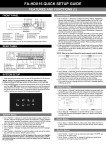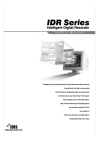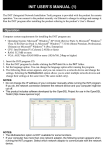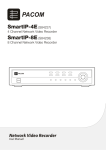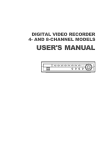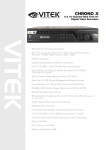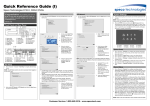Download A-ADT1600XD QUICK REFERENCE GUIDE
Transcript
A-ADT1600XD QUICK REFERENCE GUIDE FEATURES AND FUNCTIONS (1) Record Setup FRONT PANEL Camera Buttons Enter Button PTZ Button Bookmark Button Menu Button LED Arrow Buttons Alarm Button Zoom Button USB Port Jog Dial, Shuttle Ring Playback Buttons Panic Button Freeze Button Monitor Button Display Button *Select camera buttons (1-16) to view individual cameras full screens. REAR PANEL 1. Go to “Record -> General” to configure recording settings. Highlighting button toggles between On and Off. In the Recycle and pressing the Recycle mode, the DVR records over the oldest video data once all available storage space has been used. When Recycle is turned off, the DVR stops recording once all available storage space has been used. 2. Go to “Record -> General” to configure recording settings. Highlight Use Panic Recording and press the button to toggle between On and Off. When setting to On, set the length of time of the duration, images per second and quality for panic recording. 3. Go to “Record -> Schedule” to program the DVR to record only during certain times based on time, day of the week, and holidays. Highlight Schedule On and press the button to toggle between On and Off. In the Schedule On mode, the DVR records video based on the schedule established in the Schedule screen. When turning Schedule recording Off, you will be asked to confirm your decision. Panic recording will function even when Schedule is turned off. 4. Select the schedule mode between Simple Mode and Advanced Mode first. Highlight the + and press the button to add a schedule item, and button to delete highlight the box under the X heading and press the the recording settings. *NOTE: Refer to the User’s Manual for each schedule mode for details. Video Input Video Loop Through Factory Reset Switch HD/SD Selector Network Port iSCSI Port eSATA Port RS232C Port RS485 Port Alarm In/Out Audio In/Out Video Out (Primary ( HDMI/VGA/BNC), Secondary ( VGA/BNC) & Spot) Power Cord Connector SYSTEM SETUP 1. After connecting the power cord, the unit will be operational in 60 seconds. *NOTE: There is no record button on the unit. Please refer to the Configuring Record Settings section for the proper record settings. 2. Press the MENU button or move the mouse pointer to the top of the screen and then select (Setup) in the Live Monitoring menu, enter the password button. There is no default password when logging in then press the the admin user for the first time. To assure the secure management of the system, setting up a password is strongly recommended. System Setup 1. Go to “System -> General” to name the site location, assign a System ID number, select the language the screens are displayed in, display software version number, upgrade the software, import or export the DVR settings, show the System Log, clear all data and shut the system down. 2. Go to “System -> Date/Time” to enter a new date and time. 3. Go to “System -> Account” to add and delete groups and users. 4. Go to “System -> Storage” to display information about the DVR’s storage devices. 5. Go to “System -> Monitoring” to check the system events and set the actions the DVR will take when it detects system events. *NOTE: Before powering down the DVR (or logging out the current user) highlight System Shutdown from the System – General menu and press the button, and confirm whether or not you want to shut the system down (or logging out the current user). 5. Go to “Record -> Pre-Event” to set up pre-event recording. You can turn individual cameras On or Off for pre-event recording and set the image speed, image quality, resolution and the amount of time to record prior to the event (dwell). When the DVR is in the Time or Time & Event mode, it ignores the pre-event settings and follows the time settings. 6. Go to “Record -> Archive” to set the archiving schedule and data ranges. If you have not set up a storage device for archiving, a message appears notifying you of this. Network Setup 1. Go to “Network -> General” to set the transfer condition for remote watch, limit bandwidth used to the remote site and configure the WebGuard service. 2. Go to “Network -> IP Address” to select the type of network configuration first then set up LAN parameters for the selected network configuration. 3. Go to “Network -> Notification” to set the DVR to contact a computer running RAS (Remote Administration System) or to send an email when an event occurs. Event Setup 1. Go to “Event -> Motion, Alarm-In, Video Loss, Video Blind and Text-In” to set up each event and set the actions the DVR will take when it detects the event. Device Setup 1. Go to “Device -> Audio” to set up audio input and output. The DVR can record up to 16 audio inputs. 2. Go to “Device -> Alarm-Out” to change the settings and establish a schedule for each alarm output from the DVR. A-ADT1600XD QUICK REFERENCE GUIDE FEATURES AND FUNCTIONS (2) Display Setup Event Search 1. Go to “Device -> OSD” to select what information will be displayed on the monitor. 2. Go to “Device -> Primary Monitor, Secondary Monitor and Spot Monitor” to set up each monitor. See the following monitor connections examples. Move to “Search – Event Log Search, Motion Search and Text-In Search” from the Search menu to select video from the event log, select motion events and select text input strings. For more specific search conditions, select “Option” and enter search parameters then select “Search”. The search results will be displayed in each screen. Status Setup 1. Go to “Status -> Event” to display the status of the DVR’s systems and inputs. 2. Go to “Status -> Storage” to display the status of the DVR’s storage devices and the time information of recorded data. Camera Setup 1. Go to “Camera -> General” to turn the camera on and off and change the title of each camera. 2. Go to “Camera -> PTZ” to set up the PTZ cameras. Record Table Search Move to “Search – Record Table Search” from the Search menu to select video using a recording table. Recording information about video images currently displayed on the screen displays on the recording status bar LIVE MONITORING Login/Logout Monitor Freeze Export Compact View Alarm Panic Sequence Camera Menu Search Setup While in the live monitoring mode, pressing the MENU button or moving the mouse pointer to the top of the screen displays the Live Monitoring menu. Pressing the MENU button again hides the menu. You can navigate through menus and items by pressing the arrow buttons. Standard View Expanded View Go To Search Move to “Search – Go To” from the Search menu. Selecting “Go to the First” displays the first recorded image, selecting “Go to the Last” displays the last recorded image, and selecting “Go to the Date/Time” displays the Go to the Date/Time screen. CLIP COPY SEARCH AND PLAYBACK Search Go To Display Alarm Panic Camera Menu Export Data Source Exit 1. Press the button on the front panel or select (Search) in the Live Monitoring menu to enter the Search mode. 2. Press the MENU button while in the Search mode or move the mouse pointer to the top of the screen to display the Search Menu. The Clip-Copy screen can be used to copy video to an internal DVD RW, or external USB hard disk or flash drives. Move to “Export – A-B ClipCopy or Clip-Copy” from the Search menu. The clip copy can be simply done by pressing and holding the MENU button for three or more seconds. *NOTE: The Clip Copy feature requires the camera title or number along with the date and time of the recorded images to be copied. To view the copied images, remove the disk from the DVD RW device and insert it into any PC with a CD or DVD reader. On the PC access the CD or DVD drive device and select the image file name. The executable Clip Player software program will open automatically displaying playback controls for viewing the video clip. V1.0



